Islamabad: As the Met Office forecasts the heavy monsoon downpour and floods in different parts of the country from July to September, the National Institute of Health has urged the relevant authorities to take necessary measures to prevent environmental degradation, water and food contamination, and sanitation problems, which it warned can work synergistically to increase the incidence of communicable and infectious diseases.
While putting gastroenteritis, enteric fever (typhoid and paratyphoid fevers) and hepatitis on ‘high and mid alert’ respectively, it also said the departments concerned should be motivated for the effective enforcement of the preventive efforts led by the health department. “The anticipated food and water, vector borne and zoonotic disease outbreaks can only be contained through advanced preparedness and preventive measures and thus, minimising the morbidity and mortality,” NIH executive director Dr Mukhtar Ahmad told reporters here.
The NIH chief said the relevant agencies in coordination with stakeholders should ensure the daily monitoring of the situation, especially in flood-prone areas, and weekly review of the data generated by the health facilities for early detection of clustering, an aggregation of cases of a disease closely grouped in time and place.
He added that on the identification of any clusters, field investigation should be initiated immediately to assess the associated risk factors and control its further spread.
Dr Mukhtar also stressed the need for the activation of the district rapid response teams and district health management teams comprising clinical experts, public health and laboratory professionals, vector control experts and officials of other relevant departments and provision of the requisite supplies to them.
He said the authorities should also ensure the stockpiling of emergency medicines, antibiotics, anti-tetanus serum, oral rehydration therapy and intravenous fluids, anti-rabies vaccine, anti-snake venom and typhoid vaccine along with logistic support.
Besides calling for the operationalisation of the diarrhoea treatment centres, the NIH chief also asked the district health departments to monitor the acute watery diarrhoea situation on daily basis and initiate appropriate response without waiting for lab confirmation of cholera.
He warned that rainy areas, poor and congested localities were at the greater risk of having epidemics of water and food-borne infectious diseases.
“In such areas, the pipes supplying drinking water are usually old, rusted and damaged, while sewage pipes and open sewage lines run side by side and thus, contaminating water. The water-borne diseases attributed to the consumption of unsafe water and non-observance of proper sanitation and preventive measures may pose a serious challenge for the health and water and sanitation authorities,” he said.
As preventive measures against these problems, Dr Mukhtar called for the careful examination of water supply systems and immediate repair of damaged water pipes and sewage lines; chlorination of drinking water sources, regular monitoring of hotels, restaurants and food points, ice factories, street vendors and water reservoirs; focused health education campaign regarding safe drinking water, hand hygiene, food safety and better sanitation through active community participation; building of the hospitals’ capacity for better patient management; arrangements of prevention and rapid response, and regular liaison among the relevant departments.
He also suggested the establishment of flood control rooms within the district health offices to coordinate response activities with all stakeholders and said the public health professionals trained by the NIH-Field Epidemiology and Laboratory Training Programme and posted at respective provincial disease surveillance and response units in the provincial directorate general (health services) offices could be engaged to fortify the surveillance and response activities.
“These units may also be used for data collection, compilation and analysis to monitor the disease trends for timely response to epidemics,” he said.
The NIH chief said in a bid to facilitate stakeholders in their efforts for the monsoon challenge, his organisation had put the technical documents such as case definitions, guidelines for sample collection and transportation and vector control on its official website.







